Making History in Marlboro
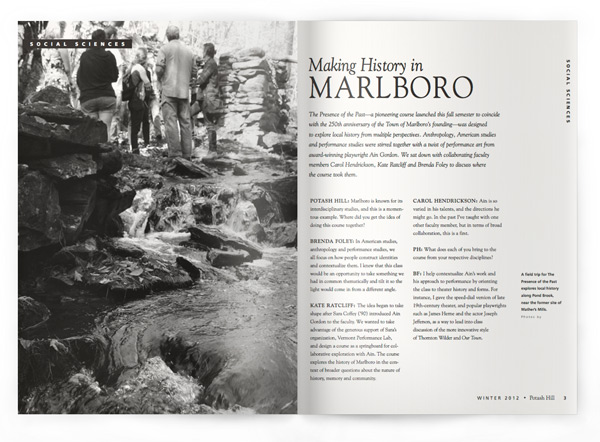
The Presence of the Past—a pioneering course launched this fall semester to coincide with the 250th anniversary of the Town of Marlboro’s founding—was designed to explore local history from multiple perspectives. Anthropology, American studies and performance studies were stirred together with a twist of performance art from award-winning playwright Ain Gordon. We sat down with collaborating faculty members Carol Hendrickson, Kate Ratcliff and Brenda Foley to discuss where the course took them.
POTASH HILL: Marlboro is known for its interdisciplinary studies, and this is a momentous example. Where did you get the idea of doing this course together?
BRENDA FOLEY: In American studies, anthropology and performance studies, we all focus on how people construct identities and contextualize them. I knew that this class would be an opportunity to take something we had in common thematically and tilt it so the light would come in from a different angle.
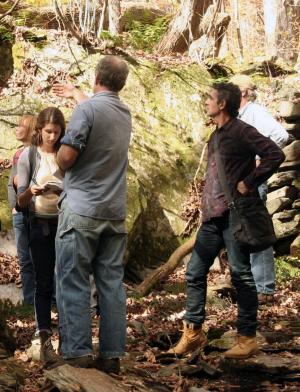
KATE RATCLIFF: The idea began to take shape after Sara Coffey (’90) introduced Ain Gordon to the faculty. We wanted to take advantage of the generous support of Sara’s organization, Vermont Performance Lab, and design a course as a springboard for collaborative exploration with Ain. The course explores the history of Marlboro in the context of broader questions about the nature of history, memory and community.
CAROL HENDRICKSON: Ain is so varied in his talents, and the directions he might go. In the past I’ve taught with one other faculty member, but in terms of broad collaboration, this is a first.
PH: What does each of you bring to the course from your respective disciplines?
BF: I help contextualize Ain’s work and his approach to performance by orienting the class to theater history and forms. For instance, I gave the speed-dial version of late 19th-century theater, and popular playwrights such as James Herne and the actor Joseph Jefferson, as a way to lead into class discussion of the more innovative style of Thornton Wilder and Our Town.
CH: I’m a learner when it comes to my own state and town, so I look to Kate for insights into history as well as wonderful readings. She keeps us honest and straight about historical facts.
KR: As someone trained in U.S. social and cultural history, I bring a wider historical context to some of the local issues we have been studying. And Carol brings expertise with fieldwork as well as a special attentiveness to material objects. I think of her as our “materials” person.
CH: And sort of “wild idea” person.
KR: And also I want to add the “cross-cultural comparative context” person. Carol can relate Guatemala to just about any subject and make it a rich point of comparison.
CH: And it’s been great having Brenda there too because two of the texts we read were plays, Our Town and Will Eno’s Middletown.
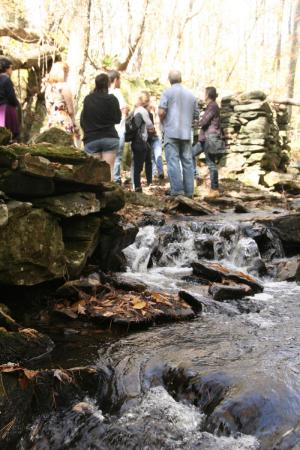
BF: I am always encouraging us to ask the question “Who is the audience?” in any piece of text, photo, pamphlet or public event—and to weigh the stated intention against the performed action. So, I point out and critique as a performance that which was not necessarily constructed nor intended to be received as one.
KR: These different disciplinary backgrounds—as well as the students’ own backgrounds—create a rich, multilayered quality to the class and the discussions.
PH: And what does Ain Gordon bring into this heady mixture?
BF: In theater and performance, my interests have always been in that which is less readily apparent or easily articulated. Ain is ever after the elusive; no moment, no detail, no historical anecdote is refuse. For Ain, in all that detritus of the past lies potential.
KR: Ain brings a creative skepticism about the whole enterprise of history. As he says, “The idea that history is knowable is a conceit of history.” Ain is drawn to the gaps, to the silences, to the margins, to that which is clearly unknowable. And his aesthetic is to continually bring attention to the constructed nature of the narrative that he’s creating. Over the past several decades, there has been an ongoing conversation about the uneasy relationship between truth and our accounts of it. Historians will say yes, we need to recognize that what we find in the past is always shaped by the cultural categories and assumptions we bring to the work. These postmodern insights are generally acknowledged, but there’s still an impulse to create a story that is more seamless than the kind of work that Ain is doing. He’s an artist, and I’m a professional historian. But the tension between those worlds is incredibly rich and interesting and fruitful.
PH: How has this course added to your understanding of the minutia of local history?
KR: Newton’s History of the Town of Marlborough is the bible of local history. Everybody cites Newton. So it’s been interesting to read Newton and think of him not as a container of facts about Marlboro, but as a historical figure himself, someone interpreting the world through the lens of his own historical moment.
CH: For instance, the language and content of Newton’s letters to his daughter is significantly different from his formal history. That’s really interesting in the context of our course.
BF: In the class we talk about people and places inscribing and performing their own history. We all leave traces, marks, impressions in our wake whether we want to or not. There are the calculated inscriptions like speeches and legislative acts, marriages and partnerships, and choices about whether we set off on our own roads less taken. And “places” make parallel choices, by committee or decree or accident, as to how they want to present in life—whether the town green gets picket fences or stone walls or who gets to lead the Fourth of July parade.

KR: We think of the iconic symbol of the New England landscape—the white steepled church and the orderly commons—as representing “traditional” New England, but that particular version of the town center was the product of a specific moment in the early 19th century. Interestingly, multiple towns in this region, including Newfane, Marlboro and Brattleboro, originally sited their meetinghouses on top of hills, and later moved them down to a more central commons. At this same time, boosters throughout New England set out to improve the landscape of the town common. They looked around and saw ungraded roads criss-crossed with oxcart ruts and unsightly sheds to protect the horses in bad weather. Marlboro’s village center has included over time an ashery, a tannery, blacksmith shop, a wheelwright shop, a wagon maker, a chair factory—industry, all right there. In the landscape aesthetic that was emerging, these activities had no place in the central village district. The new and improved village commons with its white paint and stone walls was seen as a sign of progress, not as an evocation of some traditional landscape.
CH: That was interesting to me, because when the Spanish came to what is now Latin America, they had this vision of what a city center was—a plaza—and they often built right on top of pre-existing structures. Today you can see colonial Catholic churches that were built on top of Maya temples right on the edge of plazas. All of this reflects deep roots that go way back into Maya and European pasts. So, to find out that the New England commons is a 19th-century development, as opposed to something that was there for years and years, was a revelation to me.
PH: What are some of the creative anthropological, historical, theatrical outcomes students are coming up with?
CH: We’re really pushing students to think creatively beyond a term paper and come up with something that is relevant to the class or the history of Marlboro or southeast Vermont and that challenges them to think in different ways.
KR: We’re also trying to get them to communicate what they’ve learned to a broader audience. For example, one student is writing letters between Marlboro College students in different eras; another is creating a diary based on the life of Mrs. Whitmore, a midwife and early settler; and a third is writing a play based on the idea of disease and illness in the late 18th century and how high mortality rates affected the local population.
CH: These creative projects, then, loop back into the realm of needing to require students to know historically specific details, what are considered “facts.” A student writing a diary or a set of letters from a particular era needs to know a lot about that era and how people would have written and what allusions they would have made—but not in a 21st-century way.
BF: What we’re exploring in this class is the extraordinarily rich historical detail available to students who take the time to reach into creaky attics and small town archives. They uncover inscriptions left by people who hadn’t necessarily thought of their records as a performance but who must have anticipated an audience of, at least, one reader. And in that act of communication lies a kind of inscribed performance.
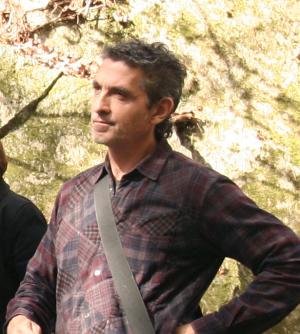 Ain Gordon (right) is a three-time Obie Award–winning playwright, director and actor whose work deals with issues of place and memory by unearthing disappearing history. His recent work includes A Disaster Begins, about one woman’s bond with the hurricane of 1900 in Galveston, Texas, and In This Place…, inspired by the first free African-Americans to build their own home in Lexington, Kentucky. Ain is a visiting artist at the Pew Center for Arts & Heritage, artist-In-residence at the Center for Creative Research and co-director of the Pick Up Performance Co(s). He first came to Marlboro as part of the Embodied Learning Symposium in April (Potash Hill, Summer 2011).
Ain Gordon (right) is a three-time Obie Award–winning playwright, director and actor whose work deals with issues of place and memory by unearthing disappearing history. His recent work includes A Disaster Begins, about one woman’s bond with the hurricane of 1900 in Galveston, Texas, and In This Place…, inspired by the first free African-Americans to build their own home in Lexington, Kentucky. Ain is a visiting artist at the Pew Center for Arts & Heritage, artist-In-residence at the Center for Creative Research and co-director of the Pick Up Performance Co(s). He first came to Marlboro as part of the Embodied Learning Symposium in April (Potash Hill, Summer 2011).
Brenda Foley is professor of theater and author of Undressed for Success: Beauty Contestants and Exotic Dancers as Merchants of Morality (Palgrave Macmillan, 2005). Her research interests are in performance studies, pop culture, feminism, contemporary theater and disability studies.
Carol Hendrickson is professor of anthropology and author of Weaving Identities: Construction of Dress and Self in a Highland Guatemala Town (University of Texas Press, 1995). She co-wrote Tecpán Guatemala: A Modern Maya Town in Global and Local Context (Westview, 2002) with Edward Fischer.
Kate Ratcliff is professor of American studies at Marlboro, where her teaching ranges from the Federalist Papers to post–World War II television sitcoms. She recently joined the board of the Vermont Academy of Arts and Sciences and participated in a panel on Vermont history at the fall conference.
Made in and around Vermont
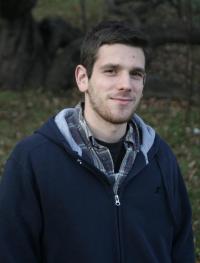 “Anyone who studies colonial America will quickly realize that no part of our history, and no geographic area, is a vacuum,” said senior Alex Tolstoi. “Everything affects everything.” For his Plan of Concentration, Alex is examining the social and political influences of neighboring colonies on 18th-century Vermont, drawing in part on historic captivity narratives. By learning about differing social and economic structures of colonial New England and New York, Alex plans to show how leaders in the Green Mountain region created a Vermont identity and raised support for an independent Republic of Vermont. “This Republic had one of the first constitutions to outlaw slavery, had no landownership requirement for suffrage and became involved in an international affair over the possibility of rejoining the English Empire.”
“Anyone who studies colonial America will quickly realize that no part of our history, and no geographic area, is a vacuum,” said senior Alex Tolstoi. “Everything affects everything.” For his Plan of Concentration, Alex is examining the social and political influences of neighboring colonies on 18th-century Vermont, drawing in part on historic captivity narratives. By learning about differing social and economic structures of colonial New England and New York, Alex plans to show how leaders in the Green Mountain region created a Vermont identity and raised support for an independent Republic of Vermont. “This Republic had one of the first constitutions to outlaw slavery, had no landownership requirement for suffrage and became involved in an international affair over the possibility of rejoining the English Empire.”
